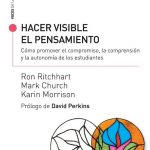16 June 2020
Promoting thinking as a basic pedagogical tool
By Ana Moreno
Thinking to learn is the title of a workshop on thinking created by Robert Swartz and David Perkins. Two of the world’s leading experts in cognitive capacity development who have also promoted the ICOT international thought conference since its inception in 1982 in the Fiji Islands. This workshop has also been given by a thousand teachers in different cities of the Spanish geography, Madrid, Seville and Barcelona.
The format of this two-day course is very practical. The two speakers alternate as they introduce different thinking strategies, routines in David and skills in Bob, while explaining some examples and proposing tasks in the audience because they, in small cooperative groups, design activities for their classrooms.
The pedagogical framework of the content is “thinking as a learning tool”. Thinking to learn is a type of philosophy, a way of understanding learning that has a double objective, on the one hand to reach a deep understanding of the curricular content and on the other to learn to think, that is, to become a competent thinker.
Routines
For David learning is often passive, lacks understanding and global vision and is little connected to the lives of the students. The solution is to help our students become “smarter” and this can be done by optimizing thinking by making it visible and explicit. “Seeing and touching” thought allows us to follow its process and understand each content more deeply and apply it more connected and more widely.
Perkins proposes using thinking routines that help the student ask questions to explore the contents while developing habits or dispositions that will make him more competent. A routine is a sequence of questions that directs thinking in a particular direction. Routines are easily learned, have few steps, and invoke high-level thinking. There are many different routines at each point in the learning cycle: 1) Preliminary ideas; 2) Introduction; 3) Understanding; 4) Application to problem solving. Other routines such as 3-2-1 Pont are metacognitive and serve to think about the same thought.

A routine is a sequence of questions that are easily learned, have few steps and invoke high-level thinking.
During the training, routines are introduced and applied to discover their potential and applicability in the classroom. Some of the most interesting routines are:
- Connect, expand, challenge
- Seeing, thinking, asking questions
- What is it? What voices make you say this?
- Step inside.
- Births, People, Interactions
- Conflicting points
- Three circles
The last three are specially designed to discover complexities in today’s world.
“Parts, people, interactions.” It is used to find possibilities to solve a complex problem. For example, to address the problem of overfishing, poverty, etc. To be able to analyse the problem it is necessary to study on the one hand all the parties involved, on the other hand the interactions between these parties, and finally the people or human groups affected.
“Conflict points.” It serves to analyze controversies, issues on which there are groups of people who think differently. The controversy is placed in the middle and the FACTS (different facts, common facts), INTERESTS (different and common practical interests), POLICIES (different, common according to groups), and VALUES (different values, common values) are analyzed. Some examples might be global warming, abortion, etc.
“Three circles.” It allows to make a wide frame to launch a theme. The innermost circle “Thinking about” stands for the central theme and the ideas of the topic. The next circle “Thinking about” Other themes in what is related in some way and are present in our life, society, etc. The outer circle “Thinking about” we use comparisons and analogies in areas that are little or not at all related, to move from the obvious to the hidden.
Research on the types of thinking that promote understanding identifies 8 different thoughts that should be promoted and made visible: 1) Observe and describe; 2) Construct explanations and interpretations; 3) Reason with evidence; 4) Establish connections; 5) Take into account different points of view; 6) Take the essential one and reach conclusions; 7) Ask questions and ask yourself questions; and, 8) Discover complexity and go beyond the surface. These 8 types of thinking form the so-called map of understanding and are the basis for the construction of thinking routines.
Within the framework of Project Zero of the Harvard School of Education, which he directed in David, another project has been developed that has revolutionized classrooms around the world, Cultures of thinking. A culture of thinking is a place where thought is valued, promoted and made visible as a basic tool for learning and collaboration.
By Ron Ritchhart, principal investigator of Project Zero, one of the 8 cultural forces that generate a true culture of thinking are the strategies, routines or skills, which make it visible. The other forces are: expectations (high, known, assessed); time (to think and ask); environment (to document, visualize learning history); modeling (competent thinker model teachers); language (incorporating cognitive terminology); opportunities (interesting, challenging, connected activities in relevant learning); interactions (relationships between materials, teachers, students that challenge thinking); and strategies (routines, skills, or techniques of critical and creative thinking).
The continued and systematic work to build cultures of thought around learning, whether in school, family, or community, ensures the development of habits of thought necessary for a happy and worthwhile life. Some of these habits are: curiosity and asking questions, open-mindedness and taking into account other perspectives, reasoning with evidence, thinking before acting, going beyond the superficial, self-evaluation and being metacognitive, etc.
Skills
For Bob, we have to learn to think because we often do so in a hasty, shallow, disorderly, or confusing way, and we need to optimize our thinking to make decisions and solve problems competently, to make predictions, to argue our ideas, or to analyze different content to understand it. Swartz proposes the learning of thinking skills and their application in learning activities that integrate curricular content and skills. This technique is called infusion and has been shown to give better results in teaching thinking than if the teaching of skills is done outside the learning content of the student, as a separate subject, since learners do not integrate it so easily.
A thinking skill is a strategy to apply a more or less complex type of thinking competently. The strategy consists of a sequence of questions, also called a thought map or orientation base, which the learner has to answer in order to apply the skill well. Each question is like a step in a procedure. There are many skills, according to the type of thinking they promote can be classified into 4 groups: Creative Thinking (generation of ideas, metaphor, etc.), Analytical Thinking (compare and contrast, relationship of the parts and the whole, classification, sequencing, argumentation, etc.), Thought Assessment (reliability of sources, causal explanation, prediction, etc.), Active Thinking (problem solving and decision making).
Applying a skill is more complex than a routine. In order to do it competently and achieve the objectives of thought and content, it is necessary to follow the methodology of a competent learning process. Therefore, the steps to do an activity with skill are the following:
- Introduce the skill. Use a simple example from everyday life. For example, compare a bench and a chair or analyse the parts of a bicycle.
- Together with learners, construct the skill’s thought map or orientation base and take notes.
- Explain the activity and guide learners in applying the skill to the content, step-by-step. Follow the thought map at all times and write responses and conclusions to the graphic organizer for the skill.
- When finished, ask learners to apply the meta-cognition scale and ask themselves what they have learned, how they have learned it, how they could improve it and in what other situation they could apply the same skill.
- Enlargement activity where the learner can apply what they have learned and make sense of it.
Applying a skill is more complex than a routine. In order to do it competently and achieve the objectives of thought and content, it is necessary to follow the methodology of a competent learning process.

The contents to which a skill is applied must lead the student to relevant learning. For example, the skill “Relationship of parts and whole” can be applied to almost any content because most things have parts that relate to each other and make them what they are. A novel or narrative has parts and each part is necessary to make sense of the whole. When we have finished analyzing the text with the skill we can ask the students to write its structure and create a new writing following it.
Other contents: a work of art, the human body, a mathematical function, a natural phenomenon whether biological, physical or chemical, a technological device, etc.
The thought map for applying this skill would be:
Relation of the parts and the whole
-
What smaller parts make up the whole?
- For each part:
- What would happen if it were missing?
- What is the function of this part?
- What would happen if it were missing?
- How do the different parts relate to each other to make the whole what it is and what it does?
- What would happen if it were missing?
Graphic organizer:
In short, a summary of the “tips” to think about in order to learn what they advise in David and Bob would be:
- Although not everyone thinks well, everyone can become a competent thinker.
- Routines and thinking skills are very powerful tools that all teachers should use.
- The basis of any step forward in learning and thinking is questions. Students have to be great questioners.
- Creating true cultures of thinking in schools requires teachers to work collaboratively on an ongoing basis.
- Working on thinking in an explicit and systematic way develops reading and visual comprehension, as well as oral and written expression.
- To make thinkers competent is to make learners competent, collaborators competent, and great communicators.
Bibliography
Most of the content of the workshop can be found in two very practical and recommended books. In them the teachers can go deeper into how to integrate thinking in their classes to make the learning 100% competent.
Related to: Article
You might also like












Leave A Comment